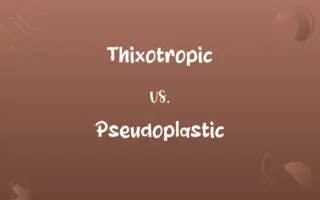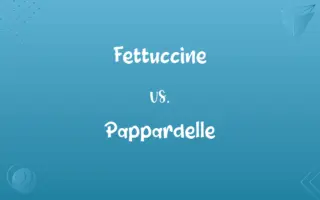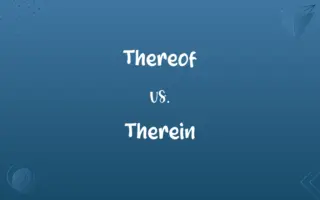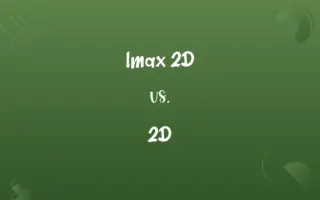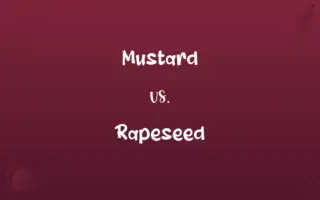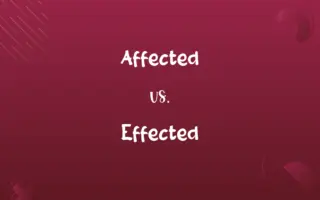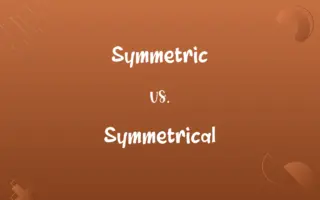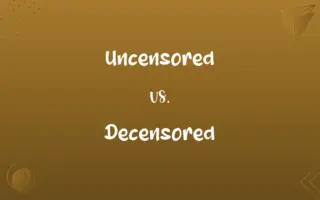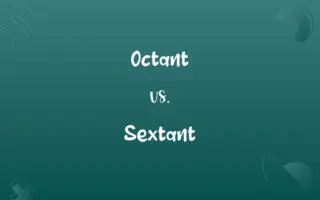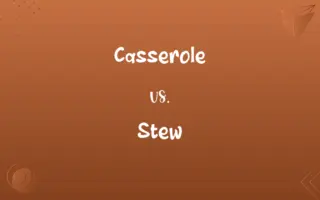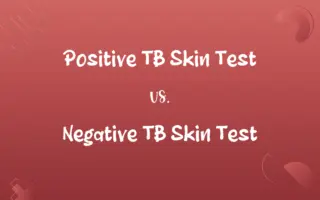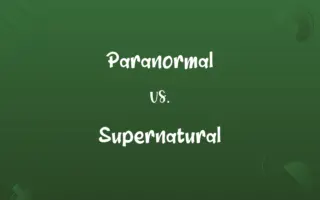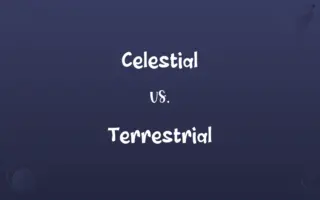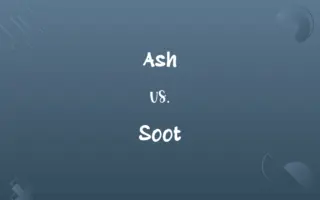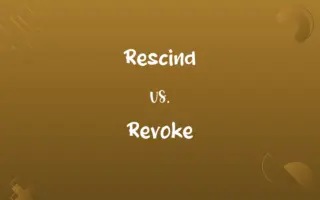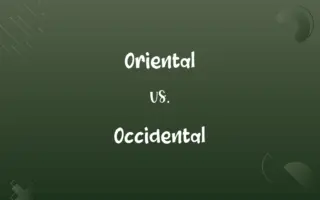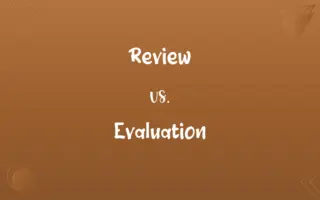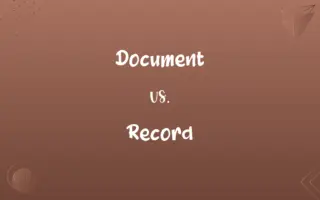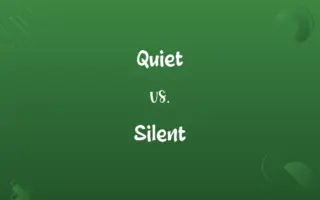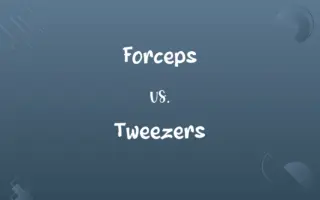Top-Down Parsing vs. Bottom-Up Parsing: Know the Difference

By Dua Fatima & Shumaila Saeed || Published on September 28, 2024
Top-down parsing starts from the root and works towards the leaves, predicting structure, while bottom-up parsing builds from the leaves up, confirming structure.
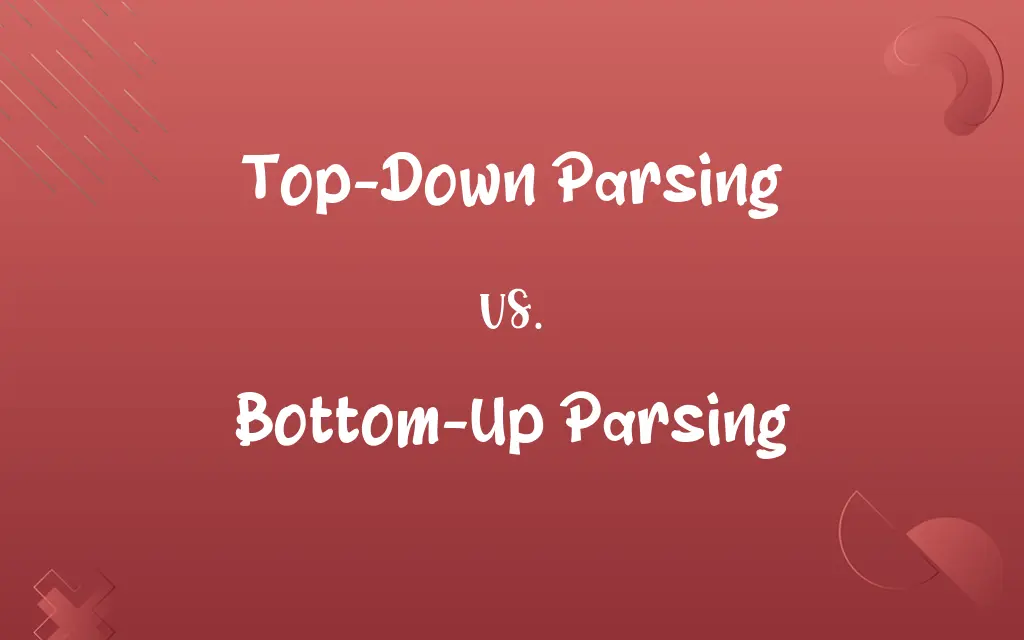
Key Differences
Top-down parsing begins with the start symbol and applies production rules to expand into a parse tree until the leaves match the input tokens. It predicts the structure of the input before matching it. Bottom-up parsing, conversely, starts with the input tokens and constructs the parse tree by progressively reducing tokens and subsequences to non-terminal symbols, ultimately reaching the start symbol.
Shumaila Saeed
Sep 28, 2024
In top-down parsing, parsers like recursive descent and LL parsers analyze input from left to right, applying rules to guess the structure of the input. Bottom-up parsers, such as LR parsers, shift input tokens onto a stack and apply reductions based on the grammar, confirming the input structure step by step.
Dua Fatima
Sep 28, 2024
Top-down parsers can struggle with left-recursive grammars, as they can lead to infinite recursion. Bottom-up parsers, adept at handling left recursion, can parse a broader range of grammars, including those that are more complex.
Dua Fatima
Sep 28, 2024
Predictive parsers, a subset of top-down parsers, use lookahead tokens to make parsing decisions without backtracking, requiring the grammar to be LL(k) for some k. Bottom-up parsers, particularly LR parsers, use a state machine and lookahead tokens to decide when to shift (read more tokens) or reduce (apply a grammar rule), handling LR(k) grammars effectively.
Hifza Nasir
Sep 28, 2024
Top-down parsing is more straightforward and easier to implement manually, making it suitable for simple grammars and compilers, bottom-up parsing is more powerful and can handle a wider range of grammars, making it preferable for more complex language constructs.
Shumaila Saeed
Sep 28, 2024
ADVERTISEMENT
Comparison Chart
Starting Point
Begins with the start symbol and expands towards the leaves
Starts with the input tokens and builds up to the start symbol
Dua Fatima
Sep 28, 2024
Parsing Method
Predictive; applies rules to guess input structure
Confirmatory; builds structure from tokens to non-terminals
Shumaila Saeed
Sep 28, 2024
Common Types
Recursive descent, LL parsers
LR parsers, including SLR, LALR, and canonical LR
Dua Fatima
Sep 28, 2024
Handling Recursion
Struggles with left recursion, may require grammar modification
Naturally handles left recursion without modifications
Shumaila Saeed
Sep 28, 2024
Grammar Suitability
Best suited for simpler, LL(k) grammars
Handles a wider range of grammars, including complex LR(k) grammars
Dua Fatima
Sep 28, 2024
ADVERTISEMENT
Implementation
Simpler to implement manually, used in compilers for simple languages
More complex, often generated by parser generators
Shumaila Saeed
Sep 28, 2024
Top-Down Parsing and Bottom-Up Parsing Definitions
Top-Down Parsing
May require grammar modification to remove left recursion.
Transforming a grammar by replacing left-recursive rules with right-recursive alternatives.
Dua Fatima
Feb 26, 2024
Bottom-Up Parsing
Uses a state machine for parsing decisions.
LR parsers use a state transition table to decide whether to shift (read more tokens) or reduce (apply a rule).
Hifza Nasir
Feb 26, 2024
Top-Down Parsing
Suitable for simple grammars and languages.
Many programming language compilers use top-down parsing for its simplicity and ease of implementation.
Shumaila Saeed
Feb 26, 2024
Bottom-Up Parsing
Confirms input structure by applying reductions.
In an LR parsing process, a reduction occurs when the items on the stack match the right side of a production rule.
Shumaila Saeed
Feb 26, 2024
ADVERTISEMENT
Top-Down Parsing
Starts analysis from the start symbol, expanding rules to match input.
Recursive descent parsers create a parse tree by recursively applying grammar rules.
Dua Fatima
Feb 26, 2024
Bottom-Up Parsing
Preferred for complex grammars and languages.
Bottom-up parsers are often used in compilers for complex programming languages due to their robustness.
Shumaila Saeed
Feb 26, 2024
Top-Down Parsing
Predicts the input structure using production rules.
An LL parser predicts which rule to apply based on the current input token and lookahead.
Dua Fatima
Feb 26, 2024
Bottom-Up Parsing
Builds the parse tree from the leaves, reducing tokens to non-terminals.
LR parsers shift tokens onto a stack and apply reductions based on grammar rules.
Dua Fatima
Feb 26, 2024
Top-Down Parsing
Can be implemented without backtracking.
LL(1) parsers use a single lookahead token to make parsing decisions without needing to backtrack.
Shumaila Saeed
Feb 26, 2024
Bottom-Up Parsing
Handles left recursion naturally without modifications.
LR parsers can parse grammars with left-recursive rules without entering infinite loops.
Dua Fatima
Feb 26, 2024
Repeatedly Asked Queries
What is top-down parsing?
Top-down parsing is a strategy that starts from the highest-level rule and expands it to match the input, predicting the structure before confirming it with the input tokens.
Shumaila Saeed
Sep 28, 2024
Can top-down parsers handle ambiguous grammars?
Top-down parsers, especially those without backtracking, struggle with ambiguous grammars as they can't reconsider choices once made.
Shumaila Saeed
Sep 28, 2024
How does bottom-up parsing work?
Bottom-up parsing begins with the input tokens and constructs the parse tree by reducing sequences of tokens to non-terminal symbols, working up to the start symbol.
Dua Fatima
Sep 28, 2024
Why is bottom-up parsing considered more powerful?
Bottom-up parsing can handle a broader range of grammars, including complex and left-recursive grammars, without needing modifications.
Dua Fatima
Sep 28, 2024
What role do parse trees play in parsing?
Parse trees visually represent the structure of the input according to the grammar, showing how rules are applied to derive the input.
Hifza Nasir
Sep 28, 2024
Are parser generators more suited for top-down or bottom-up parsing?
Parser generators are often used for bottom-up parsing due to the complexity of the parsers needed for complex grammars, although they can generate top-down parsers as well.
Dua Fatima
Sep 28, 2024
How does left recursion affect top-down parsing?
Left recursion can lead to infinite recursion in top-down parsers, requiring grammars to be rewritten to avoid left-recursive patterns.
Dua Fatima
Sep 28, 2024
What are the challenges of top-down parsing?
Top-down parsing can encounter issues with left-recursive grammars and may require grammar modification to avoid infinite recursion.
Shumaila Saeed
Sep 28, 2024
What is the significance of lookahead tokens in parsing?
Lookahead tokens help parsers make decisions about which rules to apply or actions to take, improving the efficiency and accuracy of the parsing process.
Dua Fatima
Sep 28, 2024
Is bottom-up parsing always preferable for complex languages?
While bottom-up parsing is more robust for complex languages, the choice depends on the specific requirements and complexity of the language and grammar.
Shumaila Saeed
Sep 28, 2024
Share this page
Link for your blog / website
HTML
Link to share via messenger
About Author
Written by
Dua FatimaCo-written by
Shumaila SaeedShumaila Saeed, an expert content creator with 6 years of experience, specializes in distilling complex topics into easily digestible comparisons, shining a light on the nuances that both inform and educate readers with clarity and accuracy.
